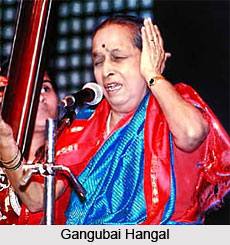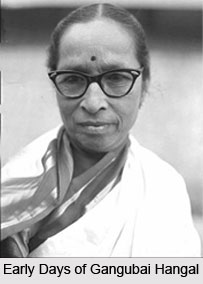 Gangubai Hangal was a maestro in Hindustani Classical Music. Her career in music lasted for eight decades, and Gangubai can be deemed as the last of the great beacons who lived through the most prolific and tumultuous eras of Hindustani music, as one whose music and outlook have come to symbolize the true grit of tradition, as well as that of uncompromising aesthetic values. Her plain attire, unaffected manners and uncompromising dedication were in itself the hallmark of the bygone era on Indian classical music.
Gangubai Hangal was a maestro in Hindustani Classical Music. Her career in music lasted for eight decades, and Gangubai can be deemed as the last of the great beacons who lived through the most prolific and tumultuous eras of Hindustani music, as one whose music and outlook have come to symbolize the true grit of tradition, as well as that of uncompromising aesthetic values. Her plain attire, unaffected manners and uncompromising dedication were in itself the hallmark of the bygone era on Indian classical music.
Early Life of Gangubai Hangal
Gangubai Hangal was born to Chikkurao Nadiger and Ambabai, who were an agriculturist and a vocalist of Carnatic music respectively. She was born in Dharwad. Gangubai Hangal did not go to any school, hence did not received any institutional education. She started her formal training in Hindustani classical music at the age of 13 at the music school of Krishna Acharya. She also took guidance from Dattopant Desai before studying under Sawai Gandharva, her respected guru.
Though stage dominated her life for a while, the allure of Sawai Gandharva`s high classicism weaned her away from the stage. She found the entire ideal and inspiring virtues that she was looking for in a guru, like dedication, perfectionism and purity of style, in the Kirana Gharana. Initially, her training sessions with him were infrequent given that he was involved with a travelling drama troupe. Fortunately, for her, the troupe soon wound up, leaving her to enjoy prolonged training sessions with Sawai Gandharva, lasting seven to eight hours a day, in his village in Kundgol, where he settled permanently. She had to travel 30 km by train from her town to reach the railway station nearest to Kundgol, from where she covered the rest of her journey to her guru`s house on foot. Her guru-bhai, Pandit Bhimsen Joshi - whom she lovingly refers to as `Bhim-anna`, would sometimes meet her at the station and walk with her to their guru`s house. Their topic of conversation was, of course, music. But her ardour for music was so great that distance never seemed to be a problem. Another singer whose music influenced her deeply was that of Zohrabai Agrewali. Growing up as she did in a predominantly Brahmin neighbourhood was nerve-racking for a sensitive girl hailing from the lower caste. She had to come face-to-face with pretty many harsh realities in everyday life, being made the hapless victim of scorn and ridicule from the Brahmin men. Yet, all these external constraints only strengthened her resolve to reach the level of perfection she envisaged.

Personal Life of Gangubai Hangal
At that time when Gangubhai Hangal was a young girl, the societal response towards the professional musician`s family was not appreciable at all. She had faced many hurdles as the daughter of Amambai and her Brahmin accommodator Shri Chikkurao Nadgir. Thus for Gangubhai, her position in the said society was undefined. Her situation became unbearable. At the age of 16 years, Gangubai Hangal was married to Gururao Kaulgi. Her husband was a Brahmin lawyer. The couple had two sons, Babu Rao and Narayan Rao, and one daughter, Krishna, who died from cancer in 2004, aged 75. When she was at her 20`s, her husband died of an illness. Gururao Kaulgi had not kept any money to live her livelihood. At that time HMV called for her first recording and paid her rupees 400.
Life in Music for Gangubhai Hangal
During her growing years, the upper caste people with whom they shared their neighbourhood made her a subject of intense ridicule. But, due her mother`s strong-willed nature, Gangubai had the courage to go forward with her lessons in music. Gangubai`s music has come to be associated with depth, dignity and gravity, matched only by her guru-bhai, Pt. Bhimsen Joshi.
As with most Kirana singers, her singing attains its haunting emotional effect when she sings the slow vilambit section in the low register. They are evident in her renditions that come as a stark contrast with other female singers in Hindustani classical. She possesses an uncanny tonal quality of grave masculinity and timbre, which astounded every listener, given her bodily structure standing just in the opposite. She was very true to her gharana style of performance in beautifully performing the vilambits.
Gangubai`s genius is best seen when she renders weighty raagas like Bhairav, Asavari, Todi, Bhimpalas, Pooorya Dhanashri, Marwa, Kedar and Chandrakauns. Her voice and approach lend these raagas a rare majesty. The absence of vocal range in her case is compensated for by depth and dignity. Her Chandrakauns, Yaman and Abhogi are all fine specimens of her art. Her longer Marwa is ruggedly expansive and gives a sense of awesome severity in the slow section, while her tarana is vigorous and lively. Of the live recordings released by Ninaad, her spacious Bhimpalas and Poorya Dhanashri are pure gold. They are instances of the rare poise she displays in her advanced years. The force and vigour of her voice have come down; but the flow is still as intense as it is pristine.
Her tenacious classicism makes her the storehouse of many noble virtues, hardly seen in the present time.
Awards and Honours Received by Gangubai Hangal
Gangubai Hangal received a number of awards in her entire career. Some of the important ones are:
* Karnataka Sangeet Nritya Academy Award, 1962
* Padma Bhushan, 1971
* Sangeet Natak Akademi Award, 1973
* Sangeet Natak Akademi Fellowship, 1996
* Padma Vibhushan, 2002
Death of Gangubai Hangal
She died on 21st July 2009 leaving behind a huge musical legacy for her fans. The Karnataka state government declared two days of state mourning for Gangubai Hangal. A state funeral was announced for 22 July in Hubli by the district commissioner of the Dharwad District.




















